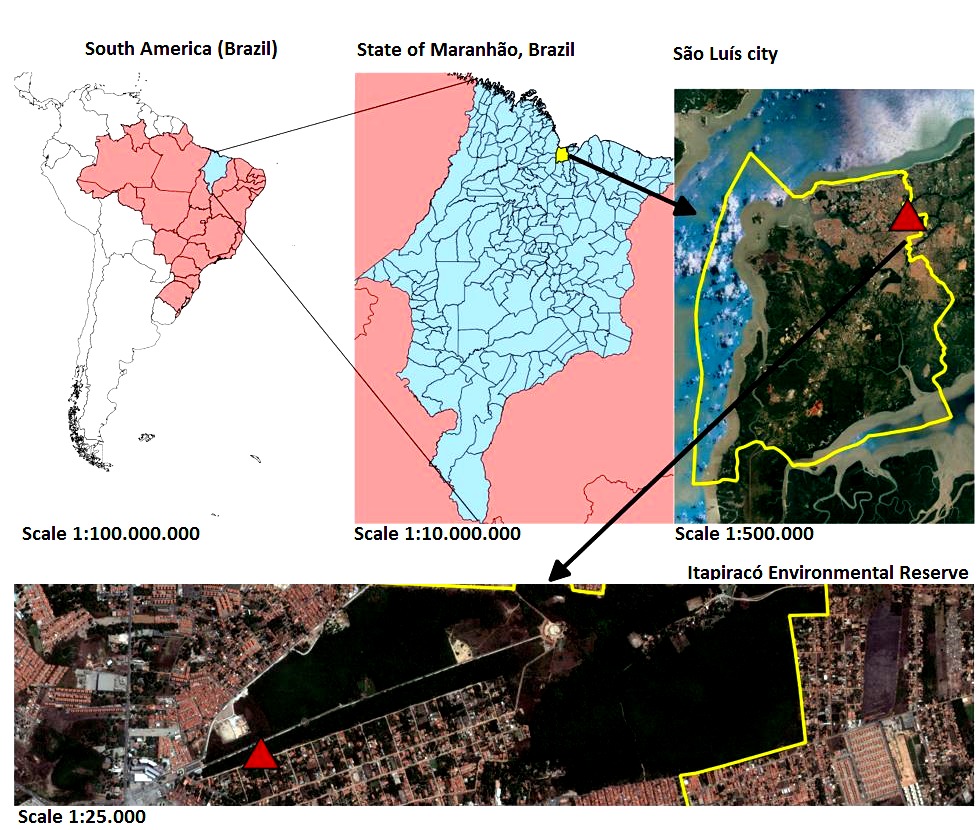|
Ehrlichia spp. (16S rRNA gene)
|
ECC (GAACGAACGCTGGCGGCAAGC) |
478 |
Murphy et al. (1998)Murphy GL, Ewing SA, Whitworth LC, Fox JC, Kocan AA. A molecular and serologic survey of Ehrlichia canis, E. chaffeensis, and E. ewingii in dogs and ticks from Oklahoma. Vet Parasitol 1998; 79(4): 325-339. PMid:9831955. http://dx.doi.org/10.1016/S0304-4017(98)00179-4.
http://dx.doi.org/10.1016/S0304-4017(98)...
|
| ECB (CGTATTACCGCGGCTGCTGGCA) |
| Nested E. canis (16S rRNA gene)
|
ECAN-5 (CAA TTATTTATAGCCTCTGGCTATAGGA) |
358 |
Murphy et al. (1998)Murphy GL, Ewing SA, Whitworth LC, Fox JC, Kocan AA. A molecular and serologic survey of Ehrlichia canis, E. chaffeensis, and E. ewingii in dogs and ticks from Oklahoma. Vet Parasitol 1998; 79(4): 325-339. PMid:9831955. http://dx.doi.org/10.1016/S0304-4017(98)00179-4.
http://dx.doi.org/10.1016/S0304-4017(98)...
|
| HE3 (TATAGGTACCGTCATTATCTTCCCTAT) |
| Nested E. chaffeensis (16S rRNA gene)
|
CHAFF (CAA TTGCTTATAACCTGGTTATAAAT) |
410 |
Kocan et al. (2000)Kocan AA, Levesque GC, Whitworth LC, Murphy GL, Ewing SA, Barker RW. Naturally occurring Ehrlichia chaffeensis infection in coyotes from Oklahoma. Emerg Infect Dis 2000; 6(5): 477-480. PMid:10998377. http://dx.doi.org/10.3201/eid0605.000505.
http://dx.doi.org/10.3201/eid0605.000505...
|
| GAIUR (GACTTTGCCGGGACTTCTTCT) |
|
A. phagocytophilum (16S rRNA gene)
|
gE3a (CACATGCAAGTCGAACGGATTATTC) |
932 |
Massung et al. (1998)Massung RF, Slater K, Owens JH, Nicholson WL, Mather TN, Solberg VB, et al. Nested PCR assay for detection of granulocytic ehrlichiae. J Clin Microbiol 1998; 36(4): 1090-1095. PMid:9542943.
|
| gE10R (TTCCGTTAAGAAGGATCTAATCTCC) |
| gE2 (GGCAGTATTAAAAGCAGCTCCAGG) |
546 |
| gE9f (AACGGATTATTCTTTATAGCTTGCT) |
|
|
| AACGGATTATTCTTTATAGCTTGCT |
|
|
Ehrlichia/Anaplasma spp. (groESL gene) |
HS1a AITGGGCTGGTAITGAAAT |
1300 - 1450 |
Sumner et al. (1997)Sumner JW, Nicholson WL, Massung RF. PCR amplification and comparison of nucleotide sequences from the groESL heat shock operon of Ehrlichia species. J Clin Microbiol 1997; 35(8): 2087-2092. PMid:9230387., |
| HS6a CCICCIGGIACIAIACCTTC |
|
|
|
Nicholson et al. (1999),Nicholson WL, Castro MB, Kramer VL, Sumner JW, Childs JE. Dusky-footed wood rats (Neotoma fuscipes) as Reservoirs of Granulocytic Ehrlichiae (Rickettsiales: Ehrlichieae) in Northern California. J Clin Microbiol 1999; 37(10): 3323-3327. PMid:10488199.
|
| HS43 AT(A/T)GC(A/T)AA(G/A)GAAGCATAGTC |
|
|
| HSVR CTCAACAGCAGCTCTAGTAGC |
1297 |
Lotric-Furlan et al. (1998)Lotric-Furlan S, Petrovec M, Zupanc TA, Nicholson WL, Sumner JW, Childs JE, et al. Human granulocytic ehrlichiosis in Europe: clinical and laboratory findings for four patients from Slovenia. Clin Infect Dis 1998; 27(3): 424-428. PMid:9770134. http://dx.doi.org/10.1086/514683.
http://dx.doi.org/10.1086/514683...
|
|
Ehrlichia spp. (omp-1 gene) |
conP28-F1 AT(C/T)AGTG(G/C)AAA(A/G)TA(T/C)(A/G)T(G/A)CCAA |
713 |
Inayoshi et al. (2004)Inayoshi M, Naitou H, Kawamori F, Masuzawa T, Ohashi N. Characterization of Ehrlichia species from Ixodes ovatus ticks at the foot of Mt. Fuji, Japan. Microbiol Immunol 2004; 48(10): 737-745. PMid:15502406. http://dx.doi.org/10.1111/j.1348-0421.2004.tb03599.x.
http://dx.doi.org/10.1111/j.1348-0421.20...
|
| conP28-R1 TTA(G/A)AA(A/G)G(C/T)AAA(C/T)CT(T/G)CCTCC |
300 |
|
| conP28-F2 CAATGG(A/G)(T/A)GG(T/C)CC(A/C)AGA(AG)TAG |
| conP28-R2 TTCC(T/C)TG(A/G)TA(A/G)G(A/C)AA(T/G)TTTAGG |
| 5’-TTCC(T/C)TG(A/G)TA(A/G)G(A/C)AA(T/G)TTTAGG-3’ |
|
Ehrlichia spp. (dsb gene)
|
dsb-330 GATGATGTCTGAAGATATGAAACAAAT |
409 |
Doyle et al. (2005)Doyle CK, Labruna MB, Breitschwerdt EB, Tang Y, Corstvet RE, Hegarty BC, et al. Detection of medically important Ehrlichia by quantitative multicolor Taq-Man Real Time Polymerase Chain Reaction of the dsb gene. J Mol Diagn 2005; 7(4): 504-510. PMid:16237220. http://dx.doi.org/10.1016/S1525-1578(10)60581-8.
http://dx.doi.org/10.1016/S1525-1578(10)...
|
| dsb-728 CTGCTCGTCTATTTTACTTCTTAAAGT |

 Thumbnail
Thumbnail
 Thumbnail
Thumbnail

